
Tech Neck Syndrome. Whether you’re caught up in doomscrolling or just checking your work emails, chances are you’re spending a lot of time on your phone and computer. But all that screen time can lead to a pesky condition called “text neck.” Hunching over your device can leave you with some severe aches and pains. So then, hold your phone up to eye level or raise your computer level up to eye level. And check out these easy tips to get rid of text/tech neck.
To reverse text neck, exercises for the neck, shoulders and upper back muscles are important to incorporate into your regular workout routine. In today’s technology-laden world. Here, neck pain caused by the time we spend slouched over our cell phones, tablets, and computers is very common. Subsequently, overtime, this can lead to chronic neck pain and more serious issues. But, keep scrolling to get started with safe and effective stretches and exercises for tech neck
What is Tech/Text Neck?

Tech Neck Syndrome. Also known as “text neck,” text neck is a term coined by a chiropractor to describe the neck pain you might feel. Consequently, after spending too much time looking down at your phone or computer.
- Tech neck is a repetitive strain condition caused by prolonged forward head posture while using electronic devices. These include smartphones, tablets, and computers.
- It may cause neck pain, headaches, and muscle imbalances that affect your back and shoulders. Over time, tech neck can lead to more serious issues, such as a pinched nerve or disc injury.
- Tech neck exercises that stretch and strengthen tight, weak muscles can improve your posture. Limiting your screen time and paying attention to your posture when using tech devices can prevent neck pain from recurring.
Leaning your Head Forward

Tech Neck Syndrome. Many people tend to lean their heads forward when they’re trying to focus on something or while slouching, and even more so while using the phone, computer or playing video games. Leaning your head forward is a common cause of neck pain, as it puts extra weight and strain on it. Human heads are heavy, so when you’re leaning forward even slightly, it puts excess stress on your neck muscles.
The easiest way to solve this is by leaning back on a chair with a high back. This type of backrest supports your head and neck, so you never have to lean forward. If your chair doesn’t have a high back, you’ll have to remind yourself to not learn forward.
Text/Tech Neck Symptoms
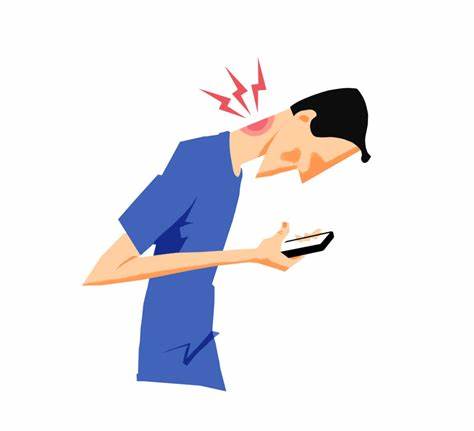
Tech Neck Syndrome. If you have text neck, here’s what you might be dealing with:
- Stiffness and difficulty moving your neck
- Dull aching or sharp, stabbing pain
- Pain that radiates into your shoulders and arms
- Weak shoulder muscles (Traps)
- Tension headaches from tight neck muscles
- Can affect your balance putting you at risk of falls
Exercises for Tech Neck
Tech Neck Syndrome. Text or Tech Neck, to help ease text neck pain, try these simple exercises. Remember the neck should be exercised/stretched gently to avoid accidental damage from going to agressivly.
Neck circles
Here’s how to safely perform neck circles: You can start seated or standing for this stretch. Whatever position you choose, tighten your core and maintain a neutral spine (no arching or hunching).
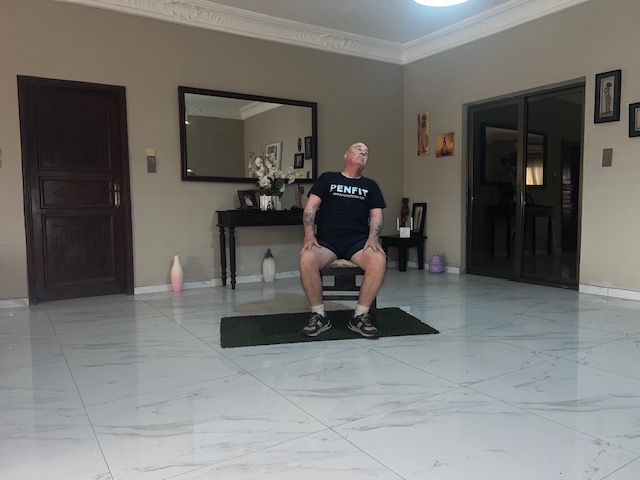
How To Do:
- Again, go VERY slowly (like a full ten seconds for one rotation), and don’t force anything!
- While sitting, slowly rotate your head 360 degrees.
- Let your jaw slack as you roll backward, and be very gentle.
- Rotate your head clockwise five times, then counterclockwise five times.
Side neck stretch
The phrase “pain in the neck” rings true for many people — in fact, neck pain is one of the top types of pain. And that is reported, according to the American Physical Therapy Association. However, neck pain can have many causes. Certain exercises and stretches can help you prevent neck pain or recover if you’re already experiencing neck pain. But if do have neck pain, it’s important to consult a healthcare professional before starting new exercise or stretching programs.
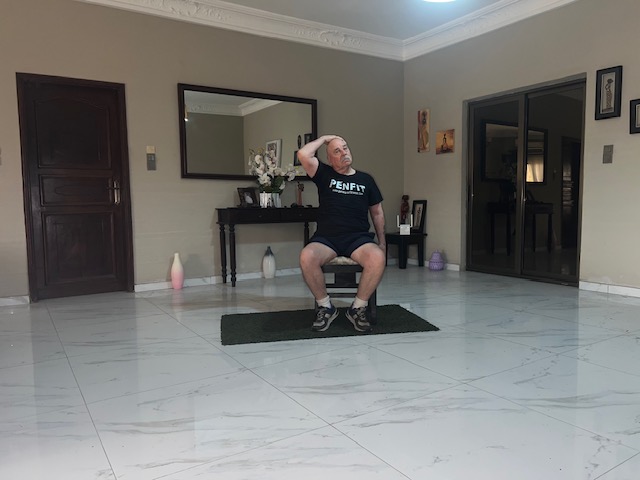
How To Do:
- Take your right hand and reach over your head to the top of your left ear.
- Use the weight of your arm to guide your head toward your right shoulder very slowly. (Don’t engage your neck muscles at all!)
- Remember to breathe deeply
- When you feel discomfort, pause and breathe again, letting your head stay there for three full breaths.
- Gently remove your hand from your head and use it to push your head slowly back up to an upright position.
- Repeat on the other side.
- Alternate until you have completed 5 on each side
Upper Trapezius Stretch
Your trapezius muscle is a large, dense muscle that begins in your neck, spans the width of your shoulders, and extends through your mid-back along both sides of your spine. You may know this muscle as your “traps.” It’s separated into three sections: the upper trapezius, the middle trapezius, and the lower trapezius.
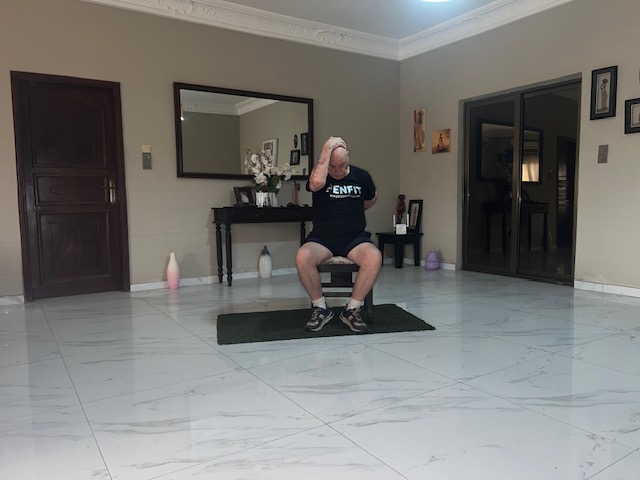
How To Do:
- Sit uppright with your head in a neutral position
- Put one hand at the small of your back, elbow to the rear
- Place your other hand lightly on your head and push gently down towards the front, untill you feel the stretch in your upper traps
- Hold for 15 seconds and release
- Repeat with the other hand for 15 seconds
Shoulder rolls
Shoulder rolls are the perfect exercise for removing accumulated stress and tension in the shoulders and improving the circulation in those joints. This exercise warms up and stretches the muscles, tendons, and joints and helps reduce pain and stiffness in the shoulder area.
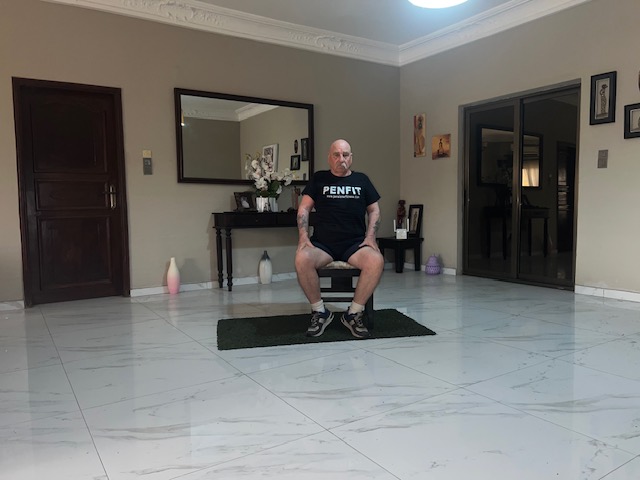
How To Do:
- Bonus: Rolling your shoulders will help with your dance moves and text neck.
- Slowly raise your shoulders.
- Without stopping, roll them back and down.
- Repeat the exercise, but roll your shoulders forward and down this time.
- Roll 10 forward and 10 backwards
Chin Tucks
Chin tucks help to realign the movements that take place when you bend your neck forward to gaze at a screen. By moving the head closer to a neutral stance with the ears directly over the shoulders, chin tucks will help with posture
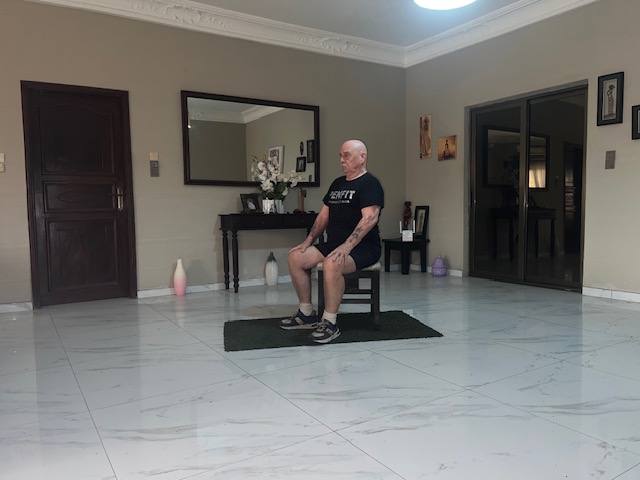
How To Do:
- Start by fixing your gaze at a particular spot across the room while sitting or standing straight.
- To help you with your motions, rest your index finger on your chin.
- Just slightly move your head horizontally and press your chin up against your neck.
- Your head should not bend downward to stare at your toes due to the movement; instead, it should cause a double chin as you keep your eyes forward.
- Hold this posture for a few seconds.
- Then return to your neutral position.
- Then relax.
- Repeat this exercise five to ten times.
Video
DONATE
Pensioner Fitness Awards
THE BUSINESS CONCEPT, BEST IN BUSINESS AWARDS
- “MOST INSPIRING SENIOR WELLNESS WEBSITE 2023“
THE GLOBAL HEALTH AND PHARMA, FITNESS AND NUTRITION AWARDS
2. “BEST SENIOR FITNESS AND NUTRITION SPECIALIST 2023“
THE MIDDLE EAST AND AFRICA BUSINESS AWARDS
3. “ MOST INCLUSIVE FITNESS PROVIDER 2023″
THE CORPORATE LIVE WIRE GLOBAL AWARDS 2023/2024
4. ” FITNESS ADVISORY PLATFORM OF THE YEAR“ 2023/2024
In Conclusion
Whether you’re caught up in doomscrolling or just checking your work emails, chances are you’re spending a lot of time on your phone. But all that screen time can lead to a pesky condition called “text neck.” Hunching over your device can leave you with some severe aches and pains.
All the corrective exercise in the world may not resolve a postural problem that is continually perpetuated. Therefore, counteracting tech neck is about not only correcting posture but also avoiding the positioning that ultimately led to the compensations in the first place.
Important Note *
Remember that everyone is different, it is ultimately YOUR RESPONSIBILITY to find what your body responds to. So please do your due diligence before trying anything new, including getting Medical Advice to ensure your safety and peace of mind.
Connect with me and leave a comment